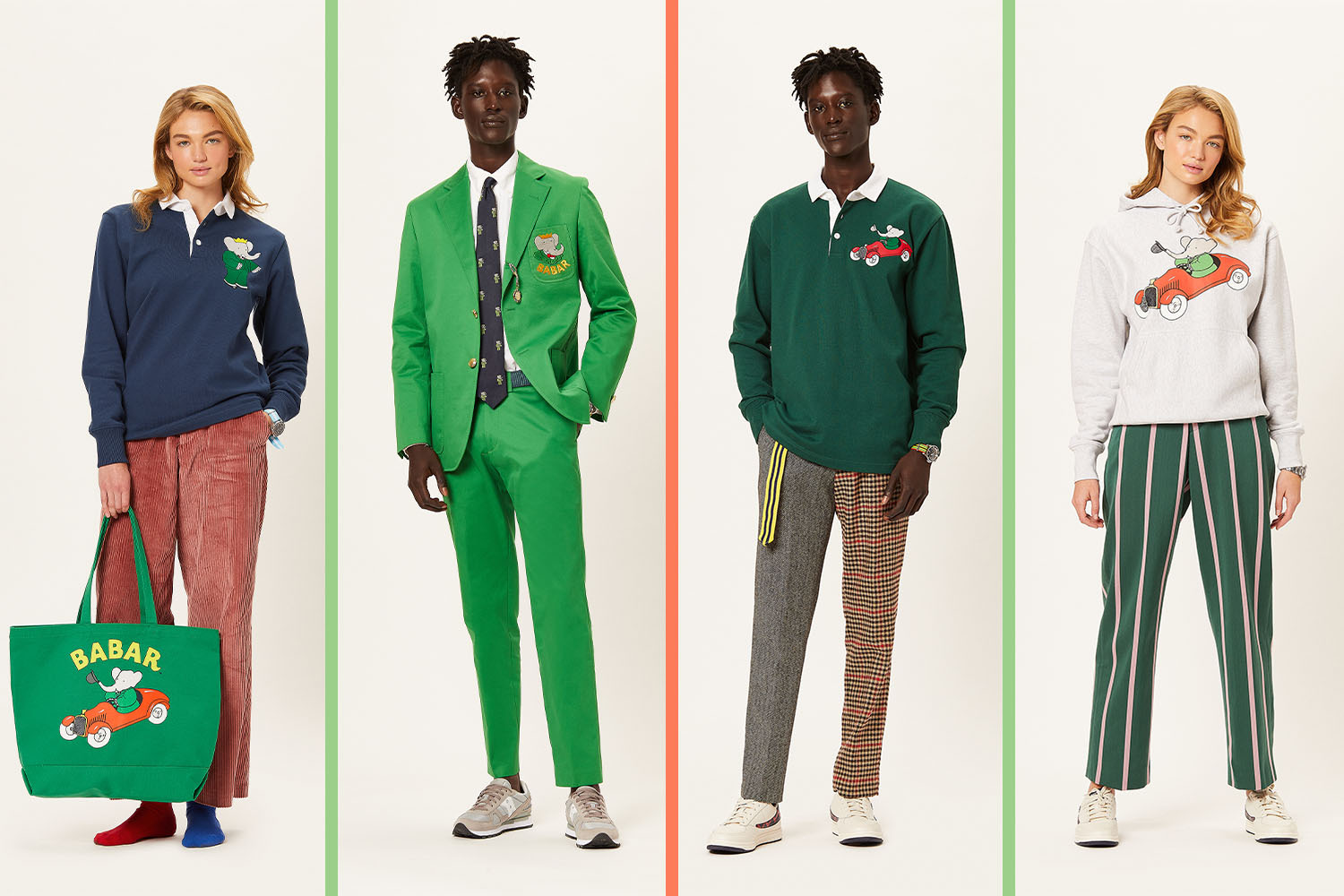On May 4th, 2013, Vampire Weekend frontman Ezra Koenig tweeted “I’m going to buy a Babar jacket. NOT a Barbour jacket, just a jean jacket w/ a big-ass Babar airbrushed on the back.”
Koenig — who eventually had his wish fulfilled, gratis, by a fan — is not alone in his desire to wear clothing marked by a royal elephant’s visage. Danish streetwear brand Soulland dropped a Babar-inspired menswear collection in 2013, and French luxury house Lanvin’s multi-season collaboration has yielded tees and four-figure knit sweaters featuring illustrations from the children’s book series.
And just this morning, the first collection in what will be an ongoing affair between Babar and American prep-meets-street brand Rowing Blazers debuted online. The initial drop sees the character reproduced on corduroy dad hats, embroidered critter pants, ties, rugby shirts and even a replica of Babar’s green suit.
It’s the first time Rowing Blazers has produced Babar-inspired merchandise, but the character has made frequent appearances on its Instagram moodboard, and vintage Babar prints sourced in Paris by founder Jack Carlson hang in the brand’s NYC store. Carlson grew up with the books, which were part of his early education in French. Though written for tykes, Carlson thinks the series continues to appeal to adults for good reason.
“They’re children’s books, but in some ways there’s a real sense of romance, adventure and style to them,” he tells InsideHook. “From the clothes he wears to the cars he drives to the places he goes on vacation, Babar’s kind of like if James Bond were running a country, was a family man, and French.”
Indeed, a Gallic sense of élan pervades the series, which began in 1931 with the publication of Histoire de Babar. Author and illustrator Jean de Brunhoff, who created the character based on a bedtime story his wife Cécile invented for their children, belonged to an upper-class Parisian family in which fine clothing was just another aspect of everyday life. There were also family connections to the world of fashion journalism: his brother was the editor-in-chief of French Vogue, and his brother-in-law was a director at Condé Nast.
Nicholas Fox Weber, author of The Art of Babar, recalls a conversation he had with Jean’s son Laurent, who would go on to write and illustrate the series after Jean’s death in 1937.
“I asked Laurent if his father was someone who cared a great deal about clothing, and the way Laurent answered, it was a different world,” Weber says. “People who had money were very well dressed; they just didn’t talk about it.”
Clothing plays a key role in the character’s origin story. In Histoire de Babar— published in English as The Story of Babar — the infantile protagonist is introduced standing on four legs, as nude as any other member of his species. But after a hunter shoots his mother, the distraught Babar runs from the jungle to a Paris-inspired metropolis, where he is adopted by a kindly old woman who foots the bill for a subsequent shopping spree. A two-page spread — which is replicated in the lining of the Rowing Blazers green suit — shows the newly bipedal elephant in a fine haberdashery, selecting a bowler hat, spats and his trademark tailoring.
“I find it incredibly significant that Babar goes from being on four legs to two legs. And when he’s on two legs is when he begins to get all dudded-up,” Weber says.
Later, Babar returns to the jungle after the reigning monarch ingests a poisonous mushroom, and our hero — who pulls up in a flashy red roadster, monogrammed luggage in the back and a bowler hat held in his trunk — is essentially crowned king on the basis of his slick fits. In subsequent books written by the father and then son, Babar continues to live the good life, changing outfits frequently as he motors, skis, dines at the White House and otherwise lives fabulously.
“It’s the high end of luxury,” Weber says. “He’s driving a Bugatti, he’s staying in a good hotel, he’s holding forth when he gives his after dinner talk,obviously in a very elegant salon. It’s definitely what we think of as upper class.”
In an era before the phrase “aspirational lifestyle” entered the popular lexicon the Babar series provided just that, particularly to American social climbers.
“It was the mark of urbanity and civilization for many Americans,” Weber says. “The first Americans to go to Europe and have wine with dinner and eat Lobster Newburg, Babar would be a part of their culture.”
Of course, such Lobster Newburg-eating Americans were a minority in the Great Depression, and that Cheeveresque world of Atlantic-crossing bourgeoisie is just as outdated as Babar’s own. So how is it that the antics of an aristocratic elephant became so popular in the first place, and have remained so nearly 100 years later?
The answer, according to Weber, is the same thing that can explain a half-century of Ralph Lauren: “The stuff of fantasies.”
“I would imagine that it’s very popular with families in lockdown,” he continues. “Because you go everywhere, you do everything, money’s no object, there’s no such thing as the virus, there’s no things inhibiting you … There’s a song from Fiddler on the Roof, ‘If I Were a Rich Man,’ and that’s Babar. He’s getting to live out the fantasy, he’s getting to do the whole thing.”
From depressions to pandemics, the pull of that fantasy has remained strong. So, if history is any indicator, we may all be enjoying — and wearing — Babar for many years to come.
This article was featured in the InsideHook newsletter. Sign up now.
